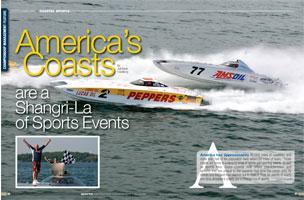
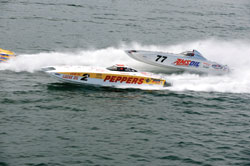 America has approximately 95,000 miles of coastline, and more than half of the population lives within 50 miles of them. Those coasts are home to a dizzying array of sports and sporting events, as well as sports fans. Every coastal mile offers characteristics and benefits that are unique to the currents that blow the ocean onto its shores and the land that reaches out to meet it. Truly, for events of nearly any kind, America's coasts are a Shangri-La of sports.
America has approximately 95,000 miles of coastline, and more than half of the population lives within 50 miles of them. Those coasts are home to a dizzying array of sports and sporting events, as well as sports fans. Every coastal mile offers characteristics and benefits that are unique to the currents that blow the ocean onto its shores and the land that reaches out to meet it. Truly, for events of nearly any kind, America's coasts are a Shangri-La of sports.
Where the Water Meets the Sea
Twenty-three American states have coastline. Alaska has the most, with more than 6,000 miles of coast. Florida, California and Hawaii are next most coast-rich. And that's just counting sea coast. If the Great Lakes - America's great "inland seas" - are taken into account, Michigan would come in second with just over 3,000 miles of coastline.
Coastal towns are home to a variety of sports, from every sport played inland to a range of sports that were invented and grew up in America's oceans and lakes. SCUBA diving, Snuba diving and snorkeling are all underwater sports that bring millions to the coast each year. While all that is going on below, thousands of boaters are making use of the water's surface. Deep sea fishing, boating, sailing, surfing and kayaking - just to name a few - all bring waves of sports fans and participants to America's coastal communities.
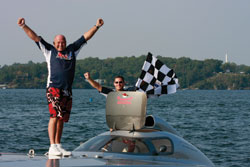 While the ocean is home to its own unique sports, America's beaches have an appeal and a following all their own. Beach sports are phenomenally popular and gaining in recognition all the time. While volleyball has been around for more than one hundred years, it took beach volleyball to really capture the imagination and passion of the world. According the International Olympic Committee, beach volleyball enjoyed a tremendous popularity surge during the Atlanta 1996 and Sydney 2000 Olympic Games, and the new fascination with volleyball carried over into a greater interest in the sport's indoor version as well.
While the ocean is home to its own unique sports, America's beaches have an appeal and a following all their own. Beach sports are phenomenally popular and gaining in recognition all the time. While volleyball has been around for more than one hundred years, it took beach volleyball to really capture the imagination and passion of the world. According the International Olympic Committee, beach volleyball enjoyed a tremendous popularity surge during the Atlanta 1996 and Sydney 2000 Olympic Games, and the new fascination with volleyball carried over into a greater interest in the sport's indoor version as well.
Volleyball's popularity surge is a testament to America's ongoing love affair with the coast. True to that romance, other beach versions of traditional sports are currently headed toward America's coastal towns, trawling enormous crowds of fans and participants behind them. Beach soccer, born on the sands of Rio de Janeiro, Brazil, has gathered an international following, one that is growing quickly in America too.
Skimboarding, a surfing/skateboarding hybrid, has also taken hold in many coastal areas. A recreational sport invented in Long Beach, California skimboarding has developed into an international competitive sport in recent years.
America's coasts are as varied as they are abundant. From the rocky coasts and cold waters of Maine to the tremendous, rolling waves of sunny California, ocean conditions as well as landscape have an enormous impact on the sports that are hosted in each coastal region.
East Coast
America's east coast abuts the Atlantic Ocean. The East Coast has a long seafaring tradition, beginning with the majestic ships that arrived on its shores with the first settlers. That tradition gave rise to boating sports of all kinds, with recreational boating, deep-sea fishing and sailing events taking place throughout the year. But the East Coast is not limited to boating; it's easy to find sports of nearly every type played on its shores and seas. Virginia Beach, according to Guinness World Records, has the longest pleasure beach in the world. They make use of that beach every year with the North American Sand Soccer Championship.
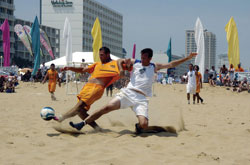 It all started in 1992, when an employee of sportswear and equipment supplier UMBRO USA mentioned to Dick Whalen, "With an oceanfront like Virginia Beach, you really ought to try sand soccer."
It all started in 1992, when an employee of sportswear and equipment supplier UMBRO USA mentioned to Dick Whalen, "With an oceanfront like Virginia Beach, you really ought to try sand soccer."
"At the time, we were trying to raise the money for a new soccer facility, and this seemed like a good fundraising idea," says Whalen. "A few of us got together every Saturday for a while, scheming and planning, and eventually, we held the first North American Sand Soccer Championship in May 1994."
That first event had 24 youth and adult teams but word spread quickly, and the event has grown exponentially ever since. Today, the North American Sand Soccer Championship is home to Sand Soccer's U.S. Open and brings together 9,500 amateur and professional players from across the world. What's more, the event long ago paid for that new soccer facility and has continued to have a huge positive economic impact on Virginia Beach.
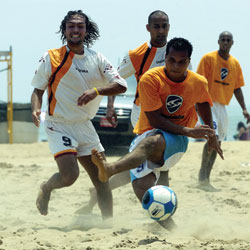 Virginia Beach has a lot more to offer than just a world-class soccer event. A resort town well accustomed to accommodating the needs of huge influxes of people, Virginia Beach is a great fit for a variety of coastal sports, including sport fishing, wind surfing and the East Coast's largest surfing event, the East Coast Surfing Championships.
Virginia Beach has a lot more to offer than just a world-class soccer event. A resort town well accustomed to accommodating the needs of huge influxes of people, Virginia Beach is a great fit for a variety of coastal sports, including sport fishing, wind surfing and the East Coast's largest surfing event, the East Coast Surfing Championships.
Also part of the East Coast, but with beaches, climate and water conditions that are unique among American coastal areas, New England combines its reputation for classic American charm with its stunning coasts for a sports event location with wide appeal.
Famous for its resort atmosphere and small town appeal, Cape Cod, Massachusetts also has a rich sailing and boating history. "The Cape" has also hosted of one of sailing's most popular races: the World Laser Championships. Laser racing is popular for amateurs as well as elite sailors across the world, receiving the highest-ever country entry in Olympic history.
New England's waters are also home to another Olympic sport, open water swimming. The Great Chesapeake Bay Swim (GCBS), occurring every June, is one of America's leading open water swimming events. This 4.4 mile is a USA Swimming-sanctioned event and draws some of swimming's most competitive athletes.
The Gulf Coast
America's Gulf Coast, made up of Texas, Louisiana, Mississippi, Alabama, and Florida, is characterized by the hundreds of barrier islands that protect hundreds of other bays and inlets. Known for it sometimes turbulent weather, the Gulf Coast is also famous for its sunny, warm climate and white sandy beaches.
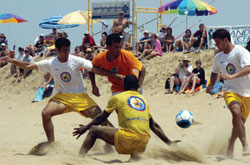 Beth Gendler, director of sales for the Alabama Gulf Coast Convention and Visitors Bureau and Sports Commission, believes that the Gulf Coast, in particular Alabama's portion of it, makes a great event location not just because of its stunning environment, but also as a result of the community that surrounds it.
Beth Gendler, director of sales for the Alabama Gulf Coast Convention and Visitors Bureau and Sports Commission, believes that the Gulf Coast, in particular Alabama's portion of it, makes a great event location not just because of its stunning environment, but also as a result of the community that surrounds it.
"So many events come here because of the great community, not just the location," says Gendler. "Orange Beach and Gulf Shores has for a long time been a family-oriented location, and we offer a great value so families can make a vacation out of sports event trips. Also, with our work as a sports commission with the cities, we make it easy to bring events here."
Fishing is one of Gulf Coast Alabama's most popular sports, since the area's many reefs promote a healthy, rich fish population. In September 2009, Orange Beach and Gulf Shores, Alabama will put its abundant waters to use with the inaugural Alabama Coastal Inshore/Offshore Kayak Fishing Tournament. The event will attract anglers from around the Southeast to fish king mackerel, Spanish mackerel, redfish, speckled trout and flounder both in the Gulf as well as and the area's back bays.
Another Gulf Coast gem, Naples, Florida has long been a resort town with a large base of devotees who return annually, both for vacation and for sports events. One of the area's most unique events is the Naples Pro/Am Skim Jam. A burgeoning extreme sport, skimboarding attracted crowds to Naples' event that surprised even its organizers.
"A local organizing committee had done the event last year on their own. This year we worked together to beef it up and low and behold, there are tens of thousands of teenagers and young adults who enter these events all over the country. It turned out to be really big," says Ralph Pryor, sports coordinator for the Sports Council of Collier County. "It was so successful, we're going to make it an annual event."
Naples beaches are a huge draw for spectator events, a fact that is evident in the popularity of its Naples Open volleyball tournament, part of the Extreme Volleyball Professionals (EVP) pro tour. The televised event, now in its second year, attracts outstanding athletes as well as enthusiastic crowds, all of whom come together in a festival-like atmosphere created by Pryor's organization in partnership with Naples' local organizing committee.
The West Coast
The heart of America's surfing culture, the West Coast has a reputation for a relaxed pace and great waves. The West Coast is a huge population center and offers a range of coastal landscapes, from the nearly tropical beaches of San Diego to the rugged, often rocky, beaches of coastal Washington State.
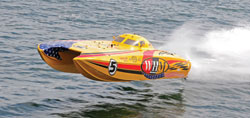 Huntington Beach, California is arguably the center of American surfing, as it is the home of the Association of Surfing Professionals North America. That's an important designation because when planning a surfing event, according to the organization's Executive Manager Meg Bernardo, location is critical.
Huntington Beach, California is arguably the center of American surfing, as it is the home of the Association of Surfing Professionals North America. That's an important designation because when planning a surfing event, according to the organization's Executive Manager Meg Bernardo, location is critical.
"The surf is the number one thing," says Bernardo. "When competitors look at the schedule, they're also going to be looking at where they're going. Those who are traveling and trying to get points are going to be looking at the break itself. Some surf big waves better, and smaller people who are light can do more on smaller waves."
The benefits a location can offer to sponsors are another concern, says Bernardo. In some events, such as Virginia Beach's East Coast Surfing Championships, the focus is to draw big crowds and create positive exposure for sponsors. For other events, big waves are the key, and the organization seeks out some of surfing's exceptional shorelines, in places like Fiji, which naturally bring in fewer spectators. Even that dynamic is changing as technology makes it possible for anyone in the world to watch an event via webcast.
In the current economy, many sports event planners are thinking a lot about cost-effectiveness. Jennifer McLaughlin, director of tourism marketing for the Irvine Chamber of Commerce says that her organization has noticed a number of coastal events moving a bit inland in order to save on costs.
"We're actually a few miles from the beach, so staying in Irvine is a good option for the budget conscious," says McLaughlin.
For participants and spectators attending events located on the nearby coast of Huntington Beach, Irvine often arranges transportation, making it easy to take advantage of the area's less expensive hotels.
The Great Lakes
The Great Lakes form America's often-overlooked fourth coast. Recreational boating and tourism are some of the Great Lakes' biggest industries, bringing large crowds of vacationers, anglers and boaters to its shores.
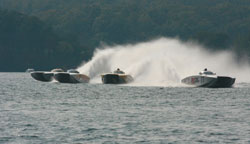 Judy Ball, executive director of the Manistee County Convention and Visitors Bureau, emphasizes one of the Great Lakes' great benefits: "We've got more fish than you need."
Judy Ball, executive director of the Manistee County Convention and Visitors Bureau, emphasizes one of the Great Lakes' great benefits: "We've got more fish than you need."
The area is well known for its king salmon and steelhead trout, and the community invests a great deal of energy into protecting their fish population and ensuring that it remains healthy and strong. Manistee is home to several major fishing competitions, including the Budweiser Pro/Am tournament, a three-day event, with a two-day pro/am tournament as well as a ladies-only fishing competition. The event is part of Michigan's Tournament Trail, the Midwest's largest circuit of fishing tournaments.
From Sea to Shining Sea
America is a country blessed with a wealth of natural resources, and its coasts are no exception. For any sport, the ideal location can be found somewhere along America's shores. Let America's coastal communities put their expertise and breathtaking location to use for your event, and watch your event succeed and grow. And maybe catch a beautiful sunset at the same time.

